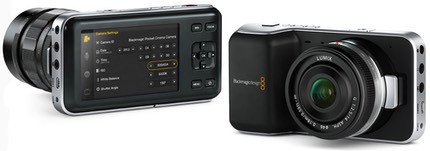Blackmagic Design last year introduced the Digital Cinema Camera (DCC), eventually producing one with an m4/3 mount (though not an active mount: no autofocus or exposure information is transferred; also note that Blackmagic had some birthing pains with the DCC, now apparently fixed).
Today at the NAB convention (National Association of Broadcasters), Blackmagic doubled down, introducing their new Pocket Digital Camera, essentially a pocket-sized m4/3 camera with an active mount that supports autofocus and exposure information. This is a pure HD video camera that records ProRes 422 (HQ) to an internal SD card with a claimed 13 stops of dynamic range, plus will eventually be able to output CinemaDNG raw, as well.

Note that the sensor isn't m4/3 sized (remember m4/3 is partly named after the aspect ratio of 4:3, and HD video is 16:9). Instead, Blackmagic Design is using a Super 16-sized sensor (7.4 x 12.5mm) behind a m4/3 mount, which means that there is a crop factor involved (3x instead of m4/3's 2x: 7mm Super 16 = 21mm full frame equivalent). Price? US$1000. Oh, and the battery? Existing Nikon EN-EL20 batteries are used. Ouch.
Now for some commentary: Nikon screwed up. How, you ask? By not correctly seeing new emerging markets and instead treating all products as if they are something new for an existing market. A V1 or V2 is nothing more than a miniature DSLR, the J3 and S1 nothing more than a big-sensor compact with interchangeable lenses. Basically, Nikon (and other Japanese camera companies) seem to think that carving existing markets into smaller ones is productive, but it isn't. The real action is in new markets and users.
Technically, the Nikon 1 cameras are slightly bigger than Super 16mm format, and we already know that the Nikon 1 cameras can do short snips of 4k video. So they ought to be of interest to videographers. Where did Nikon screw up? They think wrong about user and workflow. For example, the AVC-based compression used in most Japanese cameras all derives out of the Blu-Ray initiatives. Easy to license, easy to implement, but backwards thinking, especially since Blu-Ray as a distribution format never really took off. Casual users don't know how to edit it easily, and they really don't have any output other than just plugging into their TV.
What the video community is looking for is exactly what Blackmagic Design has been delivering, first with the Digital Cinema Camera, now with the Pocket Cinema Camera: editor-friendly compression at high bit rates. Moreover, if you've ever encountered a DCC, you know that you can enter useful metadata and name things so that they run into your video workflow correctly right from the get go. The Blackmagic cameras are production friendly in every respect, and that will even include casual video users.
Consider what would have happened if Nikon had made just a couple of small changes to the V1/V2: (1) support for uncompressed HDMI out; (2) ProRes or DNxHD compression support; (3) CinemaDNG support. Yep, bingo, every videographer in the world would have had to have one. Which is exactly what's going to happen with the Pocket Cinema Camera. It's small enough to mount of inexpensive quadcopters, it'll fit into small places on sets for POV shots, and so on.
Nikon is shooting low, and not really firing well. By my count, Nikon has yet to sell even one million Nikon 1 models to customers. So the "mass market" they attempted to win over isn't being won over. Meanwhile, there are niche markets that would certainly pay the price of a V1/V2 if Nikon would just get it configured and performing right. Nikon has almost completely missed the video revolution at this point, despite having some interesting abilities in some of their cameras. They simply haven't aimed any of those things at users.
This actually points to a problem all the Japanese camera makers have: they are all so hooked on quantity sold (mass market), that they are last to market with any true innovation. Right now a lot of that is happening in video (GoPro, Blackmagic Design, RED, etc.), but the same problem is true of still cameras, too: the camera companies are very vulnerable to operations that shoot for a specific customer and hook them. To some degree, that describes high-end m4/3 and Leica's success: the products that the Japanese camera companies should have been moving into are being mostly avoided to yet more me-too, more-pixeled compacts, bridge, entry, and even DSLR cameras.


